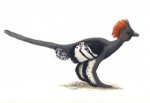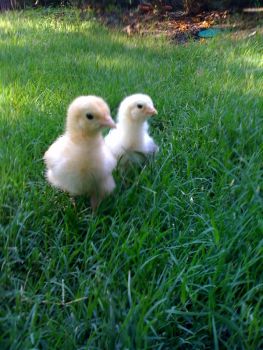Dinosaurs’ True Colors Revealed
By David B. Williams
EARTH Magazine
Modern birds range across the color spectrum from brilliant blue to Big Bird yellow to vibrant vermillion, so it stands to reason that feathered dinosaurs shared these colorful traits. And in fact, few paleontologists have doubted that dinosaurs were multihued beasts. But until a couple of recent finds in China, they had no real evidence. Two new studies detail the findings, which researchers say also resolve the debate over whether birds descended from dinosaurs.

Anchiornis huxleyi was a chicken-sized troodontid dinosaur with a chestnut mohawk, gray leg feathers, spangled black and white wings, and black feet. – Michael DiGiorgio/Yale University

Sinosauropteryx was a turkey-sized theropod with an orange back and tail with white stripes on the tail. – Chuang Zhao and Lida Xing
The studies, published in Nature and Science in consecutive weeks, focused on pigmented feathers from dinosaurs found in Liaoning Province in northeastern China. The studies revealed that the dinosaurs had gray, black, white and reddish-brown feathers.
“What they did is ground-truth our speculations, which of course is what we need in science,”
says David Fastovsky, a paleontologist at the University of Rhode Island in Kingston who was not involved in either study.
In the Nature study, paleontologists Fucheng Zhang of China’s Institute for Vertebrate Paleontology and Michael Benton of the University of Bristol in England and their colleagues used scanning electron microscopy (SEM) to examine feathers and feather-like structures called integumentary filaments from several dinosaurs from the Early Cretaceous (131 million to 120 million years ago), including Sinosauropteryx. The Science team, led by Jakob Vinther, a graduate student in molecular paleobiology at Yale University in New Haven, Conn., performed an SEM analysis of feathers across the entire body of the Jurassic-aged, 155-million-year-old Anchiornis huxleyi.
The teams took a similar approach: They analyzed the morphology and distribution of nanoscale structures called melanosomes, melanin-containing organelles that give cells pigment.
The Nature team found that Sinosauropteryx, a turkey-sized theropod (the first dinosaur ever found with feathers), featured an orange back and tail with white stripes on the tail. What the rest of the body looked like is speculative because the relative rarity of fossils precluded extensive destructive sampling of specimens.
Meanwhile, the Science team found that their chicken-sized troodontid dinosaur sported a chestnut mohawk, gray leg feathers, spangled black and white wings, and black feet — sort of like a punk pileated woodpecker.
But it’s possible that these or other feathered dinosaurs were actually much more colorful. Melanosomes only come in two chemical varieties: the rod-shaped, black-gray eumelanin and the spherical reddish-brown phaeomelanin. So, by focusing only on melanosomes, the teams were unable to detect other colors such as purple, green, red or yellow, which occur in other organic pigments, such as carotenoids and porphyrins.
Don’t expect to start seeing a whole slew of new work focusing on color, however, says Peter Makovicky, a paleontologist at the Field Museum in Chicago, Ill. Such well-preserved fossils are too rare, he says. He describes the deposit where the Chinese fossils were found as an example of a Lagerstatte, an extremely unusual deposit with just the right conditions for highly detailed preservation. In this case, a fine-grained volcanic ash settled in low-oxygen water, which prevented scavenging and decay.
But perhaps knowing what to look for will prompt other paleontologists to look for melanosomes in fossils they already possess, says Luis Chiappe, director of the Dinosaur Institute at the Natural History Museum of Los Angeles County in California. This will require slight damage to fossils (to remove a microscopic piece of the specimen), but he hopes that curators will open up their specimens to help tell the story.
“This will become contagious,” he says.
Even more intriguing than the color question, however, is what the research says about dinosaur and bird evolution, Fastovsky says.
“This is the ‘nail in the coffin’ for those who doubt that birds really are dinosaurs,”
he says, because these new studies provide even more evidence that these dinosaurs were covered with true feathers, identical to those found in modern birds.
“In addition, the studies help show that what we call a bird evolved over a long, shaded and graded process, going from a feathered non-flying dinosaur ancestor to a modern flying bird. We used to think that when we saw that flight had evolved in Archaeopteryx it meant a bird. Now we realize that feathers aren’t exclusively about flight.”
Indeed, the work also helps clarify why dinosaurs evolved feathers. The first feathers couldn’t have been for flight, Makovicky says. In the beginning, they were merely simple filaments that became more complex throughout the evolution of meat-eating dinosaurs. Early feathers would be more useful for insulation, and the fact that they were colorful suggests they may have also evolved to serve a display function, such as defense, camouflage and recognition, he says.
Vinther’s team also proposed that the importance of color to sexual selection could have helped drive feather evolution.
“Feathers could have become larger and larger for sexual display, and that use secondarily evolved for flight,” Vinther says.
That may be true, but such a hypothesis is untestable, Chiappe notes. Furthermore, he says, it is not necessary to develop such a complex structure as a feather for color — skin could be colored as well.
These studies
“show how dinosaur studies are shifting. We are starting to study them in a fashion similar to how we study living animals,” Makovicky says.
“It really brings dinosaurs to life not just in our imagination but with real data.”
Williams is a freelance writer in Seattle, Wash.
Source: EARTH Magazine







Comments
Dinosaurs’ True Colors Revealed — No Comments